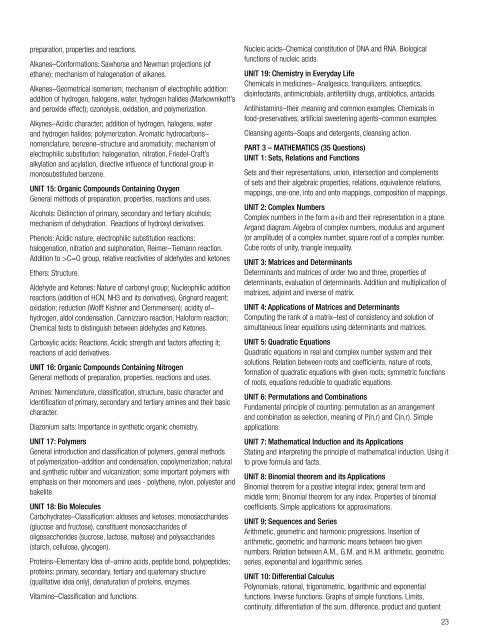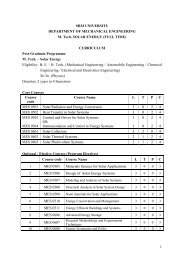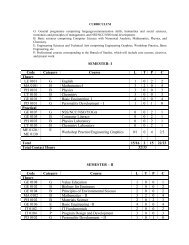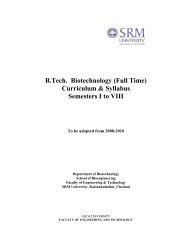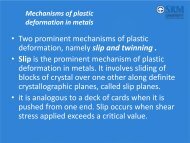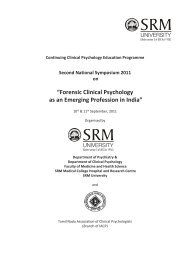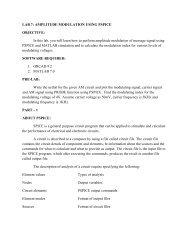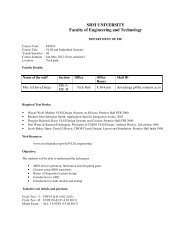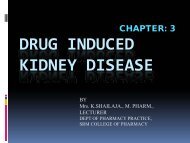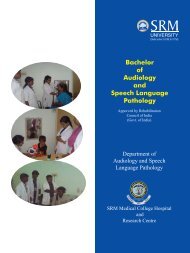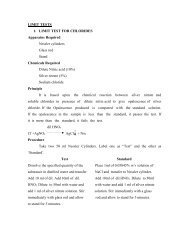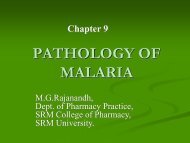Guide to Entrance Exam - SRM University
Guide to Entrance Exam - SRM University
Guide to Entrance Exam - SRM University
You also want an ePaper? Increase the reach of your titles
YUMPU automatically turns print PDFs into web optimized ePapers that Google loves.
preparation, properties and reactions.<br />
Alkanes–Conformations: Sawhorse and Newman projections (of<br />
ethane); mechanism of halogenation of alkanes.<br />
Alkenes–Geometrical isomerism; mechanism of electrophilic addition:<br />
addition of hydrogen, halogens, water, hydrogen halides (Markownikoff’s<br />
and peroxide effect); ozonolysis, oxidation, and polymerization.<br />
Alkynes–Acidic character; addition of hydrogen, halogens, water<br />
and hydrogen halides; polymerization. Aromatic hydrocarbons–<br />
nomenclature, benzene–structure and aromaticity; mechanism of<br />
electrophilic substitution: halogenation, nitration, Friedel-Craft’s<br />
alkylation and acylation, directive influence of functional group in<br />
monosubstituted benzene.<br />
UNIT 15: Organic Compounds Containing Oxygen<br />
General methods of preparation, properties, reactions and uses.<br />
Alcohols: Distinction of primary, secondary and tertiary alcohols;<br />
mechanism of dehydration. Reactions of hydroxyl derivatives.<br />
Phenols: Acidic nature, electrophilic substitution reactions:<br />
halogenation, nitration and sulphonation, Reimer–Tiemann reaction.<br />
Addition <strong>to</strong> >C=O group, relative reactivities of aldehydes and ke<strong>to</strong>nes<br />
Ethers: Structure.<br />
Aldehyde and Ke<strong>to</strong>nes: Nature of carbonyl group; Nucleophilic addition<br />
reactions (addition of HCN, NH3 and its derivatives), Grignard reagent;<br />
oxidation; reduction (Wolff Kishner and Clemmensen); acidity of–<br />
hydrogen, aldol condensation, Cannizzaro reaction, Haloform reaction;<br />
Chemical tests <strong>to</strong> distinguish between aldehydes and Ke<strong>to</strong>nes.<br />
Carboxylic acids: Reactions, Acidic strength and fac<strong>to</strong>rs affecting it;<br />
reactions of acid derivatives.<br />
UNIT 16: Organic Compounds Containing Nitrogen<br />
General methods of preparation, properties, reactions and uses.<br />
Amines: Nomenclature, classification, structure, basic character and<br />
identification of primary, secondary and tertiary amines and their basic<br />
character.<br />
Diazonium salts: Importance in synthetic organic chemistry.<br />
UNIT 17: Polymers<br />
General introduction and classification of polymers, general methods<br />
of polymerization–addition and condensation, copolymerization; natural<br />
and synthetic rubber and vulcanization; some important polymers with<br />
emphasis on their monomers and uses - polythene, nylon, polyester and<br />
bakelite.<br />
UNIT 18: Bio Molecules<br />
Carbohydrates–Classification: aldoses and ke<strong>to</strong>ses; monosaccharides<br />
(glucose and fruc<strong>to</strong>se), constituent monosaccharides of<br />
oligosacchorides (sucrose, lac<strong>to</strong>se, mal<strong>to</strong>se) and polysaccharides<br />
(starch, cellulose, glycogen).<br />
Proteins–Elementary Idea of–amino acids, peptide bond, polypeptides;<br />
proteins: primary, secondary, tertiary and quaternary structure<br />
(qualitative idea only), denaturation of proteins, enzymes.<br />
Vitamins–Classification and functions.<br />
Nucleic acids–Chemical constitution of DNA and RNA. Biological<br />
functions of nucleic acids.<br />
UNIT 19: Chemistry in Everyday Life<br />
Chemicals in medicines– Analgesics, tranquilizers, antiseptics,<br />
disinfectants, antimicrobials, antifertility drugs, antibiotics, antacids.<br />
Antihistamins–their meaning and common examples. Chemicals in<br />
food-preservatives, artificial sweetening agents–common examples.<br />
Cleansing agents–Soaps and detergents, cleansing action.<br />
PART 3 – MATHEMATICS (35 Questions)<br />
UNIT 1: Sets, Relations and Functions<br />
Sets and their representations, union, intersection and complements<br />
of sets and their algebraic properties, relations, equivalence relations,<br />
mappings, one-one, in<strong>to</strong> and on<strong>to</strong> mappings, composition of mappings.<br />
UNIT 2: Complex Numbers<br />
Complex numbers in the form a+ib and their representation in a plane.<br />
Argand diagram. Algebra of complex numbers, modulus and argument<br />
(or amplitude) of a complex number, square root of a complex number.<br />
Cube roots of unity, triangle inequality.<br />
UNIT 3: Matrices and Determinants<br />
Determinants and matrices of order two and three, properties of<br />
determinants, evaluation of determinants. Addition and multiplication of<br />
matrices, adjoint and inverse of matrix.<br />
UNIT 4: Applications of Matrices and Determinants<br />
Computing the rank of a matrix–test of consistency and solution of<br />
simultaneous linear equations using determinants and matrices.<br />
UNIT 5: Quadratic Equations<br />
Quadratic equations in real and complex number system and their<br />
solutions. Relation between roots and coefficients, nature of roots,<br />
formation of quadratic equations with given roots; symmetric functions<br />
of roots, equations reducible <strong>to</strong> quadratic equations.<br />
UNIT 6: Permutations and Combinations<br />
Fundamental principle of counting: permutation as an arrangement<br />
and combination as selection, meaning of P(n,r) and C(n,r). Simple<br />
applications.<br />
UNIT 7: Mathematical Induction and its Applications<br />
Stating and interpreting the principle of mathematical induction. Using it<br />
<strong>to</strong> prove formula and facts.<br />
UNIT 8: Binomial theorem and its Applications<br />
Binomial theorem for a positive integral index; general term and<br />
middle term; Binomial theorem for any index. Properties of binomial<br />
coefficients. Simple applications for approximations.<br />
UNIT 9: Sequences and Series<br />
Arithmetic, geometric and harmonic progressions. Insertion of<br />
arithmetic, geometric and harmonic means between two given<br />
numbers. Relation between A.M., G.M. and H.M. arithmetic, geometric<br />
series, exponential and logarithmic series.<br />
UNIT 10: Differential Calculus<br />
Polynomials, rational, trigonometric, logarithmic and exponential<br />
functions. Inverse functions. Graphs of simple functions. Limits,<br />
continuity, differentiation of the sum, difference, product and quotient<br />
23


